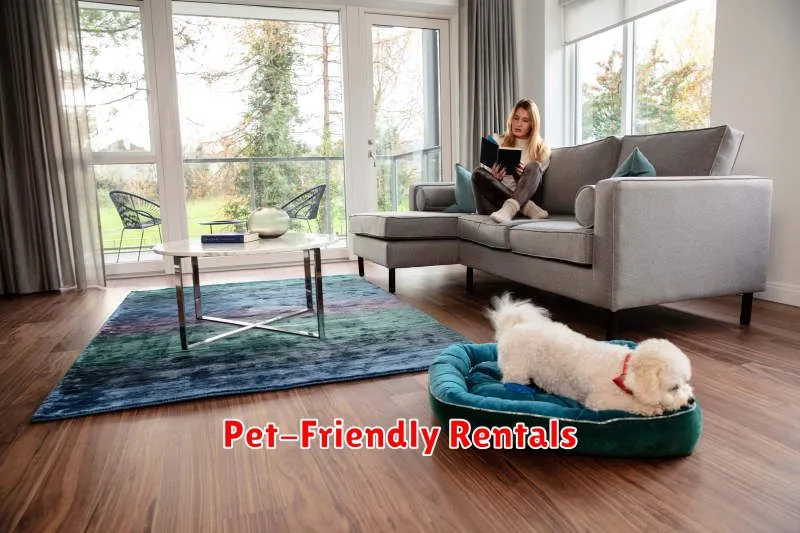Finding the perfect pet-friendly house rental can be a challenge, but it doesn’t have to be a stressful experience! This comprehensive guide will walk you through the process of securing a rental home that welcomes your furry, feathered, or scaled family members. We’ll cover everything from searching for pet-friendly properties and understanding pet policies to negotiating with landlords and ensuring a smooth move-in. Get ready to discover amazing pet-friendly rentals and create a happy home for you and your beloved companions!
Why Pet-Friendly Rentals Are in Demand
The demand for pet-friendly rentals is booming, driven by a significant shift in societal attitudes towards pets. More and more people view their pets as beloved family members, not just animals.
This increased bond translates into a strong desire to keep pets close, even when relocating or changing living situations. Reluctance to leave a pet behind during a move is a major factor in the search for pet-friendly housing.
Furthermore, the growing pet ownership rates worldwide are directly influencing the rental market. With more people owning pets, the need for accommodation that welcomes them increases proportionally. Landlords who cater to this need are likely to attract a larger pool of potential tenants.
Finally, convenience and reduced stress are key drivers. Finding pet-friendly housing eliminates the significant emotional and logistical challenges associated with finding separate arrangements for pets, leading many renters to actively prioritize pet-friendly options.
What to Look for in a Pet-Friendly Property

Finding a pet-friendly rental can be challenging, but knowing what to look for will greatly improve your chances. Pet policies are the first thing to check; some landlords have breed restrictions or weight limits. Carefully review these to ensure your pet is allowed.
Beyond the policy, consider the property’s features. A fenced yard is ideal for dogs, providing a safe space to play. For cats, a screened-in porch or balcony can offer outdoor access without escape risks. Sufficient space is key, allowing your pet to move comfortably. Think about the layout – is there enough room for your pet’s bed, toys, and food bowls without overcrowding?
Also, consider the surroundings. Is the neighborhood safe and quiet? Are there nearby parks or walking trails? Proximity to veterinary care can also be crucial. Remember to discuss any pet-related concerns directly with the landlord before signing the lease to avoid future disagreements. Clear communication is vital to a positive experience for both you and your pet.
Finally, be prepared to provide proof of pet vaccinations and possibly pet insurance. Landlords often request this documentation to ensure responsible pet ownership. Demonstrating your commitment to responsible pet ownership can significantly increase your chances of approval.
How to Negotiate Pet Policies with Landlords
Finding a pet-friendly rental can be challenging, but don’t give up! Many landlords are willing to consider pets, especially with a little negotiation. Preparation is key. Before contacting a landlord, gather information about your pet: breed, size, age, and any behavioral issues. Having this ready demonstrates responsibility.
Approach the landlord proactively. Don’t wait for them to bring up the pet policy. Mention your pet early in your communication, showcasing your responsible pet ownership. Offer to provide references from previous landlords or veterinarians.
Be prepared to offer concessions. This might include a higher security deposit, increased monthly rent, or a pet resume detailing your pet’s temperament and training. Consider offering to pay for professional carpet cleaning at the end of your lease.
Present yourself as a responsible tenant. Highlight your strong rental history, stable income, and commitment to maintaining the property. Emphasize your pet’s good behavior and your willingness to address any potential concerns the landlord might have.
Put it in writing. Once you reach an agreement, ensure it’s documented in your lease or an addendum. This protects both you and the landlord. Be clear about all pet-related terms, including any fees and responsibilities.
Be polite and professional throughout the negotiation process. Even if you don’t get the outcome you hoped for, maintain a respectful attitude. Remember, a positive interaction could benefit you in the future.
Negotiating a pet policy requires clear communication and a willingness to compromise. By being prepared and presenting yourself as a responsible pet owner, you significantly increase your chances of finding the perfect pet-friendly home.
Understanding Additional Costs for Pet Rentals
Finding a pet-friendly rental can be a relief, but remember that welcoming your furry friend often comes with extra costs. These charges vary significantly depending on the landlord and the property.
Pet Deposits are common. This is a refundable sum held by the landlord to cover potential damages caused by your pet. The amount can range from a few hundred dollars to a multiple of your monthly rent, and it’s usually returned at the end of your lease after an inspection.
Pet Rent is another frequent expense. This is a recurring monthly fee, separate from your regular rent, that contributes to the cost of upkeep and potential damage related to your pet. The amount varies widely.
Some landlords also charge a one-time pet fee. This is a non-refundable fee paid upfront to cover administrative costs associated with accepting pets.
Beyond these standard charges, consider potential increased cleaning fees at the end of your lease. Even with a pet deposit, extensive cleaning might incur extra costs if your pet leaves behind significant damage or messes.
Breed restrictions can indirectly impact your costs. Some landlords prohibit certain breeds, potentially limiting your options and forcing you to pay more for a pet-friendly property that doesn’t have these restrictions. Always clarify pet policies before signing a lease agreement.
Before committing to a rental, carefully review the lease agreement to fully understand all pet-related costs. Don’t hesitate to ask the landlord or property manager to clarify any unclear terms to avoid surprises.
Tips for Finding Pet-Friendly Listings Online
Finding a pet-friendly rental can be challenging, but with the right online strategies, you can significantly increase your chances of success. Here are some key tips:
Use specific keywords: When searching on rental websites, don’t just search for “apartment” or “house.” Use keywords like “pet-friendly apartments,” “dog-friendly rentals,” or “cat-friendly houses.” Be as specific as possible about your pet’s type and size.
Filter your search effectively: Most rental websites have robust filtering options. Make sure to utilize the “pet-friendly” filter to narrow down your results immediately. Some sites may allow you to specify the number and type of pets allowed.
Check individual listing descriptions carefully: Even if a listing isn’t explicitly labeled “pet-friendly,” some landlords may be open to pets on a case-by-case basis. Always read the full description and look for clues, or contact the landlord directly to inquire about pet policies.
Explore niche pet-friendly rental websites: Several websites specialize in listing pet-friendly properties. These sites often have more comprehensive details about pet policies, making your search more efficient. Look for websites dedicated to pet-friendly housing.
Be prepared to provide information about your pet: Landlords often require information about your pet, such as breed, size, and age. Having this information readily available will speed up the process and demonstrate your responsibility as a pet owner.
Consider expanding your search area: If your initial search yields limited results, consider expanding your geographic search radius. A slightly longer commute might be worth it for the right pet-friendly home.
By employing these strategies, you’ll be well-equipped to find the perfect pet-friendly rental online, ensuring a comfortable and welcoming home for both you and your furry friend.
Conclusion: Renting a Home for You and Your Pets
Finding a pet-friendly rental can feel overwhelming, but with the right approach, it’s entirely achievable. Remember to be upfront about your pets during your search, highlighting their positive attributes and providing any necessary documentation. Thoroughly review lease agreements to understand all pet-related rules and fees. By being prepared and proactive, you can find the perfect home for you and your furry, feathered, or scaled companions.
Don’t be discouraged by initial setbacks. Persistence is key. Keep expanding your search, utilize various online resources, and don’t hesitate to contact landlords directly. The reward of finding a welcoming and comfortable home for both you and your beloved pets is well worth the effort.
Ultimately, successful pet-friendly renting hinges on open communication, responsible pet ownership, and a willingness to comply with the landlord’s terms. By demonstrating you are a responsible tenant and pet owner, you significantly increase your chances of finding a wonderful place to call home, along with your cherished animal friends.

